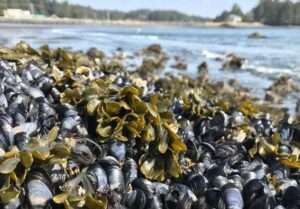
The Kodiak region of Alaska has had a long-standing problem with paralytic shellfish poisoning, the dominant harmful algal bloom (HAB) concern in Alaska. A new five-year research partnership led by Alaska Sea Grant will enhance capacity for HAB monitoring by building on efforts of tribal members in the Koniag region with the addition of rapid toxin tests, new laboratory methods and capacity, as well as extended training and educational opportunities. This effort will help mitigate HAB toxin risks in Kodiak Archipelago communities and advance NOAA HAB forecasting capabilities for the region.
A total of $1.5 million from the NOAA Monitoring and Event Response for Harmful Algal Blooms Research Program is supporting this research led by Alaska Sea Grant in collaboration with the Kodiak Area Native Association, SeaTox Research Inc., and the National Centers for Coastal Ocean Science Harmful Algal Blooms Forecasting Branch. The work builds on past research by project team members in the region and benefits from collaborations with key partners including the Knik Tribe of Alaska, Sitka Tribe of Alaska Environmental Research Lab, and several Tribal organizations within the Kodiak region.
“Our project team has been working together in one way or another for years to address harmful algal blooms in the Kodiak region,” said Alaska Sea Grant project investigator, Julie Matweyou. “This funding opens doors for continued collaborations to conduct this important work, and the funding of this project demonstrates the importance of partnerships to serve our communities.”
Subsistence harvesting is a major food resource and culturally significant among Native villages in Alaska’s Kodiak Archipelago, and food security is impacted by recurrent blooms of toxic Alexandrium species. These blooms have also impacted development of the Kodiak mariculture industry, as most early mariculture efforts were abandoned due to recurring PSP toxins. This project will help inform both subsistence harvest and developing mariculture in Kodiak waters.
“This is very exciting,” said Kodiak Area Native Association Environmental Programs supervisor Andie Wall. “Kodiak Tribes, UAF, and other partners have been monitoring for harmful algal blooms for many years. KANA initiated support for HAB monitoring in 2019. With this new funding and continued partnership, we will be able to provide long-term monitoring and support food security for the region.”
Data will be shared to help mitigate harmful algal bloom impacts in the Koniag region, including the City of Kodiak, the greater Chiniak Bay area, and some communities off the road system. Additional remote communities will have the opportunity to participate as the project progresses. Coordination and information-sharing between communities will be strengthened by building on established Alaska Sea Grant and KANA efforts, and with local education and training.
This project will allow the Kodiak Seafood and Marine Science Center’s HAB laboratory to screen for shellfish toxins using the new SeaTox enzyme-linked immunosorbent assay test developed through earlier partnerships. The SeaTox test utilizes a novel antibody, coupled with a conversion step, that allows for detection of the most potent versions of the PSP toxins. Rapid detection will inform research efforts and direct testing of shellfish intended for consumption.
The team anticipates this project will allow for an expansion of current efforts to map Alexandrium cyst distributions in local waters to identify where future blooms may occur, as well as support efforts to develop and validate an Alexandrium HAB forecast model for Kodiak. Community sampling efforts will be supported through expansion of monitoring at local beaches.
Harmful algal blooms and the toxins they produce can damage ecosystems, local communities, and coastal economies. They cost the U.S. economy millions of dollars each year through impacts to public health, losses in recreation and tourism, effects on fisheries, and associated monitoring and management efforts. Funding for this Alaska-based project was announced as a part of NOAA’s $20.1 million in funding nationwide towards HAB and hypoxia research projects and monitoring activities throughout U.S. coastal and Great Lakes waters.
To learn more, visit the NOAA Harmful Algal Bloom website. For details on recent HAB research in Kodiak, see the following stories: Research informs where and when harmful algal blooms may occur and Research fellow helps Kodiak address harmful algal blooms.
